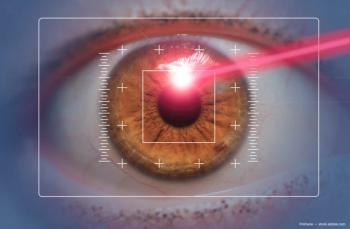
Engaging OCTA in glaucoma imaging
A prospective, observational study found that eyes with mild POAG could be differentiated from pre-perimetric glaucomatous eyes, which also could be differentiated from normal eyes using OCTA-derived retinal vessel density measurements.
Reviewed by Vikas Chopra, MD
Ophthalmologists could have a new tool to assess progression in glaucoma by measuring vascular damage in the retina and optical nerve head. Optical coherence tomography angiography (OCTA) can directly measure retinal vessel densities in a non-invasive, reliable, and reproducible manner, and provide indirect measurements of ocular perfusion and blood flow.
“We know that retinal blood flow is reduced with increasing glaucoma severity,” said Vikas Chopra, MD.
“We have not had an easily performed, reliable, noninvasive method to assess retinal blood flow or changes in retinal blood flow before OCTA,” said Dr. Chopra, associate professor of clinical ophthalmology, David Geffen School of Medicine, University of California Los Angeles, associate medical director, Doheny Image Reading Center, and medical director, UCLA Doheny Eye Centers.
“Retinal specialists already use OCTA to assess retinal vascular in various diseases, and glaucoma specialists should soon be able do the same after some software tweaking to eliminate measurement artifacts and derive quantitative measures of blood flow,” he added.
Dr. Chopra was senior author on a proof-of-concept study that used swept-source OCTA (DRI OCT Triton, Topcon) to distinguish between normal eyes versus eyes with pre-perimetric glaucoma versus eyes with early primary open-angle glaucoma (POAG).
Ophthalmologists recognize that ischemia plays a role in apoptotic ganglion cell death and that glaucoma patients typically suffer from impaired ocular blood flow. Current diagnostic and management methods for glaucoma depend exclusively on the measurement and control of intraocular pressure (IOP).
While epidemiologic and clinical evidence have long indicated risk factors other than IOP in glaucoma, IOP has long been the only risk factor which clinicians could both measure routinely and modify.
OCTA provides high-speed, three-dimensional images of both small and large vessels within the retina in real time using motion contrast.
The technique uses comparisons of repeat scans acquired at the same position in the retina to detect changes in blood flow.
This microvascular mapping provides details of perfusion in the retina and optical nerve head without the use of contrast media and using equipment that is currently available in most ophthalmologic practices.
“OCTA may require a software upgrade, but it is available on almost all platforms used in ophthalmology practices today,” Dr. Chopra said. “The capability has been there and we are finally working out the practicalities of using OCTA to assess glaucoma as routinely as the retina specialists use the technology in retinal diseases.”
The UCLA team used OCTA to compare optic nerve head and peripapillary retinal vessel densities in age-matched groups of normal eyes versus pre-perimetric glaucoma versus early POAG. Retinal blood vessel density measurements using OCTA showed a consistent stepwise decrease from normal eyes to pre-perimetric glaucoma eyes to mild POAG eyes. There was a statistically significant difference in peripapillary vessel density, optic nerve head vessel density, and papillary vessel density among all three groups (p < 0.001).
Dr. Chopra’s results mirror a growing list of similar studies that have found clear association between reduced blood flow at the retina and optic nerve head and glaucoma. Reduction in retinal vascular density alone is sufficient to distinguish among the three groups of normal, pre-perimetric glaucoma, and early POAG.
What is most illuminating and interesting is that the data suggest the vascular changes in the retina may develop early in the glaucoma process, well before the recognition of any deterioration of the visual field.
Retinal vascular changes may not develop solely as a result of glaucomatous atrophy, but likely begin before the moderate-to-advanced stages of disease. That suggests that reduced retinal density and reduced retinal blood flow measurements could provide additional parameters that might be used in the clinical setting for earlier glaucoma diagnosis and management.
“These parameters have the potential to be used in a complementary fashion to currently utilized OCT-derived retinal nerve fiber layer measurements in earlier stages of glaucoma, and even be correlated to visual field defects in moderate and advanced stages of glaucoma,” Dr. Chopra said. “The problem is that, at this point, OCTA gives qualitative measures of retinal blood flow, but not yet the kind of quantitative measure or score needed for routine clinical use. Deriving a clinically useful score is just a matter of tweaking the algorithms that are already in place and collecting additional data.”
Projection artifacts
Another potential roadblock is the appearance of what are called projection artifacts that are similar to shadows cast on the deeper vasculature by vessels located near the surface.
Fortunately, the data collected to date suggest that vascular damage related to glaucoma tends to affect the more superficial (inner) layers of the retina, which makes current OCTA technology usable regardless of projection artifacts.
At the same time, continuing software improvements are reducing the impact of projection artifacts, extending the useful range of OCTA into deep layers of the retina.
“OCTA is not quite ready for routine clinical use in glaucoma, but that time is coming,” Dr. Chopra said.
“Researchers at UCLA and other centers continue to advance the practical application of this technology to glaucoma. We might expect to see the first clinically useful applications of OCTA in glaucoma begin to emerge within the next six to 12 months.”
Vikas Chopra, MD
This article was adapted from a presentation by Handan Akil, MD, research fellow in Dr. Chopra’s lab, at the 2017 meeting of the American Society of Cataract and Refractive Surgery. Dr. Akil has since returned to practice in Turkey. Dr. Chopra has a financial interest with Allergan.
Newsletter
Don’t miss out—get Ophthalmology Times updates on the latest clinical advancements and expert interviews, straight to your inbox.













































.png)


